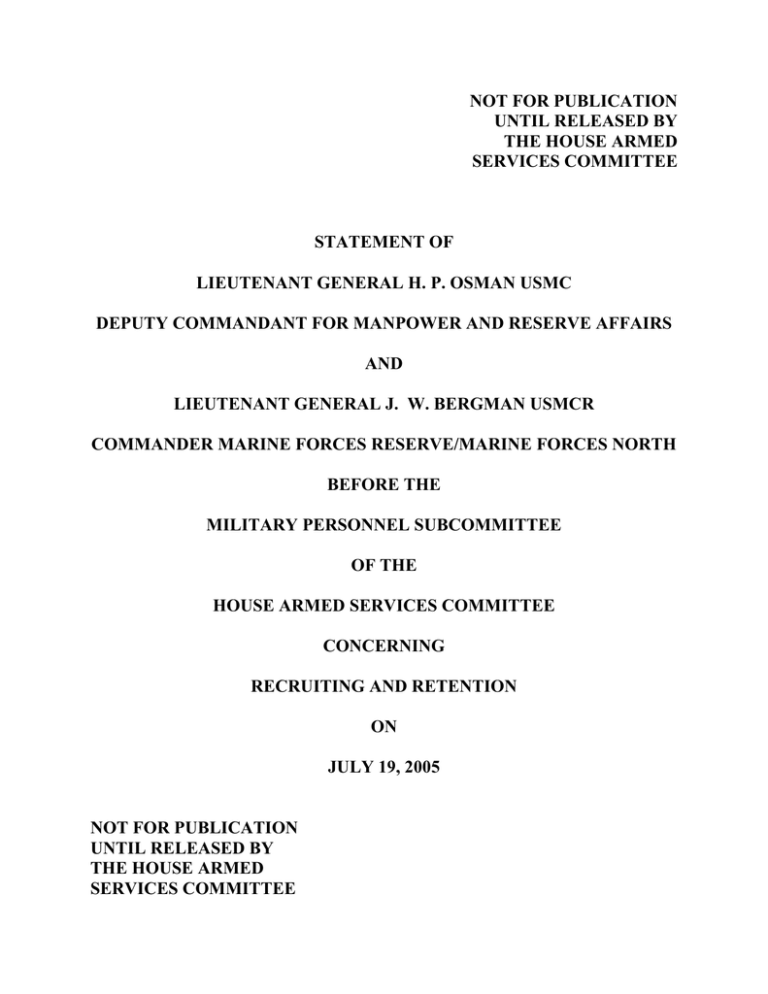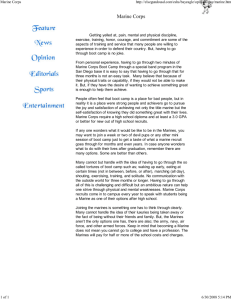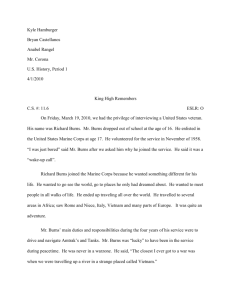Document 10722115
advertisement

NOT FOR PUBLICATION UNTIL RELEASED BY THE HOUSE ARMED SERVICES COMMITTEE STATEMENT OF LIEUTENANT GENERAL H. P. OSMAN USMC DEPUTY COMMANDANT FOR MANPOWER AND RESERVE AFFAIRS AND LIEUTENANT GENERAL J. W. BERGMAN USMCR COMMANDER MARINE FORCES RESERVE/MARINE FORCES NORTH BEFORE THE MILITARY PERSONNEL SUBCOMMITTEE OF THE HOUSE ARMED SERVICES COMMITTEE CONCERNING RECRUITING AND RETENTION ON JULY 19, 2005 NOT FOR PUBLICATION UNTIL RELEASED BY THE HOUSE ARMED SERVICES COMMITTEE Chairman McHugh, Congressman Snyder, and distinguished Members of the Subcommittee, it is my privilege to appear before you today to provide an update on recruiting and retention in your Marine Corps. Today, over 28,000 of your Marines – regular and reserve, of all military occupational specialties – are deployed in Iraq, Afghanistan and elsewhere in the Central Command area of operation. Many are directly engaged in combat operations. Additionally, we have approximately 6,000 Marines deployed worldwide in support of other combatant commanders. The Marine Corps is a learning organization, and we continue, in close coordination with our joint and coalition partners, to develop new means to ensure that our Marines – our most lethal weapons and our Corps’ most precious assets – are properly trained, equipped and organized to succeed in the face of an intelligent and adapting enemy. Along with our focus on effectively fighting the current fight, we continue to prepare to ensure our forces can rapidly respond to new threats and future contingencies. I would again like to thank you for your sustained fiscal and moral support of your Marines and their families. Recent Operations and Current Status of Forces Since February 2005, the II Marine Expeditionary Force has completed a relief in place and transition of authority with the I Marine Expeditionary Force and is currently executing multiple security, urban combat, nation building and counter-insurgency and force protection missions with great confidence and skill, in the face of an adaptable and dangerous enemy in the heart of the Sunni Triangle. Marines are fully engaged in the training and establishment of the Iraqi Armed Forces. Highly motivated and professionally adept Marines are currently training, supporting, and operating with the new Iraqi Army. We continue to aggressively match our training and equipment to the changing threat. Finally, in the Central Command area of operation, the 26th Marine Expeditionary Unit (Special Operations Capable) is supporting MultiNational Division-South East in Iraq, providing anti-terrorism training to the Kingdom of Saudi Arabia, and conducting bi-lateral training with the Hashemite Kingdom of Jordan. We expect our commitment to Operation IRAQI FREEDOM to remain at about 23,000 Marines and Sailors into 2006, with the Marine Corps Reserve Forces providing about 4,000 of these Marines. 1 In Afghanistan, your Marine Corps continues to support Operation ENDURING FREEDOM with an Infantry Battalion, an EA-6B squadron, and two Embedded Training Teams with the Afghan National Army. In the coming months, the Marine Corps will expand its participation in the training of the Afghan National Army as well as the training and development of the Afghan National Police. These Marine forces are a major element of the Combined Joint Task Force assigned to defeat the remaining elements of the Taliban, Al Qaeda, and Al Qaeda affiliated organizations, “operationalize” and deploy the new Afghan Army, solidify and “professionalize” the Afghan National Police, and set the conditions for a successful National Assembly Election in September of this year. In addition to these operations, our concurrent support to other regions including the Pacific, the Republic of Georgia and Central and South America, exhibit the flexibility and effectiveness of your Marines in prosecuting the Global War on Terror and solidifying relationships with foreign governments. All of these demonstrate our continued resolve to be the world's foremost expeditionary warfighting organization – always interoperable with joint, coalition, and interagency partners – creating stability in an unstable world with the world's finest warriors – United States Marines. The entire Marine Corps is supporting this sustained effort and no forces have been fenced. This means that many Marine units in the operating forces are either deployed or training to relieve deployed units. In an effort to sustain and regenerate Marine forces for service in Iraq, and in response to lessons learned, the Marine Corps has trained and deployed a sizable number of both active and reserve provisional units – including cross-training artillery, tank and engineer units in security, military police, transportation, civil affairs, and foreign military training missions. 2 The Marine Corps continues to provide well trained Marines and units to meet our operational commitments worldwide, and our overall operational readiness in the Iraq and Afghanistan theaters remains high. This has come at a cost though. Current operational tempo has had an impact on unit readiness. Since the beginning of Operation IRAQI FREEDOM, overall unit readiness for battalion and squadron-sized units has dropped by 14 percent. Our readiness priority remains support and sustainment of our forward deployed forces at the immediate expense of those units that have rotated out of Operation IRAQI FREEDOM. As a consequence, the readiness of the force not deployed has decreased. With your continued support in resetting and reconstituting our forces, we will continue to meet our forces for sustained operations in Iraq and Afghanistan and improve our readiness for any additional contingencies in the future. Despite the high operational tempo, the morale and commitment of your Marines remain high. We continue to work aggressively to manage this high tempo and still meet the requirements of the Combatant Commanders. End Strength. Active. The current end strength of 178,000 is allowing the Marine Corps to increase manning in our infantry units; create a dedicated Foreign Military Training Unit; add additional recruiters; and increase training infrastructure and other support to our operating forces. Coupled with initiatives implemented as part of the recent force structure review and our military to civilian conversions, we will place more Marines in our operating forces to reduce the tempo of operations on Marines and separation from their families. As of June 30th our actual end strength was 178,231 and we project that we will have 179,248 Marines on September 30th. 3 Reserve. Despite no change in our Reserve end strength of 39,600, the recent force structure review will allow the Marine Corps to reorganize internally and thus create an Intelligence Support Battalion, an Anti-terrorism Battalion, two LAR companies and additional Civil Affairs Detachments to better support mission requirements. It is projected that the Reserve end strength will be at 40,056 on September 30th. Military to Civilian Conversions. Another important component to our warfighting and readiness strategy is military to civilian conversions. The Marine Corps continues to pursue sensible military to civilian conversions to increase the number of Marines in the operating force. We are on course to achieve 1,500 conversions in fiscal year 2005 and are planning additional conversions for fiscal year 2006. Recruiting Successful recruiting is essential to replenishing the force and maintaining a high state of readiness. Fiscal Year 2005 is proving to be the most difficult recruiting year we have had in 10 years. We believe the recruiting “marketplace” will become even more challenging in Fiscal Year 2006. Your support for an increase in enlistment bonus programs will be essential to meet this challenge. Active Component. Eight months into the Fiscal Year 2005 recruiting year, we have shipped 102 percent of our Fiscal Year 2005 active component goal with 95 percent being Tier I High School graduates. Active officer accessions will achieve its goals. In enlisted contracting for next year, we are slightly behind where we had planned to be at the end of June. We have achieved 97 percent of our 8-month contracting goal. Reserve Component. The Marine Corps Reserve has also achieved its Fiscal Year 2005 8-month recruiting goal, shipping 100 percent of its non-prior service goal and accessing 107 4 percent of its goal for prior-service Marines. Again, we project to meet our recruiting goals this year. We will also meet our reserve component, officer-recruiting goals. Accomplishing the Mission. The Marine Corps’ recruiting environment is dynamic and challenging, particularly with regards to market propensity. Our success in the future will hinge on our ability to overcome our target market’s low propensity to enlist and the increased cost of advertising, while maintaining innovation in our marketing campaign. Marketing by its very nature requires constant change to remain relevant. While our brand message of “Tough, Smart, Elite Warrior” has not changed, the Corps continues to explore the most effective manner to communicate and appeal to the most qualified young men and women of the millennial generation. Currently, we have expanded our methods to influence the parents of potential applicants. Parents are the primary influencers of the high school student population and it is important that we educate them on the benefits of serving in the Marine Corps. Ensuring young men and women and their parents hear and understand the recruiting message requires continual reinforcement through marketing and advertising programs. To do this we continue to emphasize paid media, generating leads for recruiters, and providing the recruiters with effective sales support materials. Quality advertising aimed at our target market provides the foundation for establishing awareness about Marine Corps opportunities among young men and women. Paid advertising continues to be the most effective means to communicate our message and, as a result, remains the focus of our marketing efforts. As advertising costs continue to increase it is imperative that our advertising budgets remain competitive in order to ensure that our recruiting message reaches the right audience. Marine Corps recruiting successes over the past years are a direct reflection of a quality recruiting force and an effective and efficient 5 marketing and advertising program. In addition to funding support to advertising, strong funding support for the Enlistment Bonus Programs is essential to allow our recruiters to successfully compete with the industry for young men and women with high demand skill sets. The Enlistment Bonus and Marine Corps College fund constitute of only 16% of the Marine Corps Manpower discretionary funding authority. (Note that only 1% of the Marine Corps Manpower funding is discretionary.) Recruiter Access. The Marine Corps continues to benefit from the legislation enabling recruiter access to high school student directory information, the same as afforded other prospective employers. America’s youth can learn about career opportunities in both the public and private sectors now that our recruiters are afforded equal access. We need to your continued support as we strive to meet the increasing challenges of a dynamic recruiting environment. Our Reserve Marines also serve as an important symbol to America’s youth; our presence in hometowns among friends and families does much to inspire others to join. We continue our efforts to build a strong network throughout America with Reserve units active in their communities, with our peacetime/wartime support teams, and with our Marine for Life program. Retention A successful recruiting effort is but one part of placing a properly trained Marine in the right place at the right time. The dynamics of our manpower system must match skills and grades to our Commanders’ needs throughout the operating forces. The Marine Corps endeavors to attain and maintain stable, predictable retention patterns. However, as is the case with recruiting, civilian opportunities abound for Marines as employers actively solicit our young Marine leaders for private sector employment. Duty Station options, leadership opportunities, our core values, and other similar intangibles are a large part of the reason we retain dedicated 6 men and women to be active duty Marines after their initial commitment. Of course, retention success is also a consequence of the investments made in tangible forms of compensation and in supporting our operating forces – giving our Marines what they need to do their jobs in the field, as well as the funds required to educate and train these phenomenal men and women. Enlisted Retention. We are a young force. Achieving a continued flow of quality new accessions is of foundational importance to well-balanced readiness. Within our 158,641 Marine active duty enlisted force, over 27,000 are still teenagers and 104,000 are on their first enlistment. In Fiscal Year 2005, our career force requirement requires that we reenlist approximately 25 percent of our first-term Marine population. To better manage the career force, we introduced the Subsequent Term Alignment Plan in Fiscal Year 2002 to track reenlistments in our active career force. For Fiscal Year 2005, we have made our aggregate reenlistment goals for both the first term and career force. First Term reenlistments total 5,984 and represent 100.6 percent of our goal with a 96.2 percent MOS match. Subsequent Term reenlistments total 5,669 and represent 111.6 percent of our goal with an 81.1 percent MOS match. The Selective Reenlistment Bonus program greatly complements our reenlistment efforts and clearly improves retention within our critical skill shortages. The bonus played a critical roll in the achieving a high retention in critical infantry MOSs this year. The Corps continues to pay lump sum bonuses, thus increasing the net present value of the incentive and positively influencing highly qualified, yet previously undecided, personnel. It is a powerful influence for the undecided to witness another Marine’s reenlistment and receipt of his or her Selective Reenlistment Bonus in the total amount. Increased funding support for the Selective Reenlistment Bonus is a critical requirement for the 7 Marine Corps as we anticipate having to further expand our bonuses into the rotary wing aviation and combat service support MOSs due to their continuing high OPTEMPO. Selective Reenlistment Bonuses account for approximately 60 percent of our one percent discretionary funding authority. The Marine Corps takes great pride in prudent stewardship of the resources allocated to the critical Selective Reenlistment Bonus program, but also realizes that the current OPTEMPO will result in a higher demand to pay bonuses to keep our best and brightest. A positive trend continues concerning our first term non-expiration of active service attrition – those Marines who depart before their enlistment is completed. As with Fiscal Years 2003 and 2004, we continue to see these numbers decrease. The implementation of the Crucible, Unit Cohesion programs and concerned focused leadership, continue to contribute to improved retention among our young Marines who assimilate the cultural values of the Corps earlier in their career. Current Selected Marine Corps Reserve enlisted retention is at 84.2 percent as compared to the historical average of 81.6 percent. MOS match is at 83.9 percent compared to the historical average of 81percent. We are mindful that our Reserve Marines must juggle their Marine Corps duty with civilian jobs and education, income considerations, and ensuing family concerns. To that end, we strive to provide state of the art equipment, challenging training, predictable deployment schedules, responsive family programs, and a strong network at our Reserve sites throughout the nation. Your continued support for these important programs is greatly appreciated. Officer Retention. Overall, we continue to achieve our goals for both active and reserve officer retention. . CONCLUSION 8 Through the remainder of Fiscal Year 2005 and into Fiscal Year 2006, our Nation will remain challenged on many fronts as we prosecute the Global War on Terrorism. Services will be required to meet commitments, both at home and abroad. Soldiers, Sailors, Airmen, and Marines are the heart of our Services – they are our most precious assets – and we must continue to attract and retain the best and brightest. With your support, a vibrant Marine Corps will continue to meet our nation’s call as we have for the past 229 years! Thank you for the opportunity to present this testimony. 9






